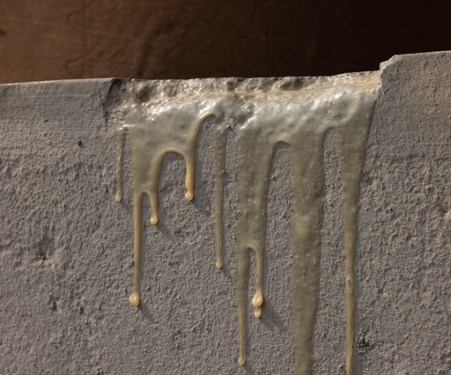
Material research documentation for Wound Response, Lagos, Nigeria, 27 January 2024; material: natural liquid latex; photo credit: Elise Fredericksen; Courtesy of the artist
Born Sydney, Australia (1984), lives and works in Sydney, Australia
Wound response 2024
natural liquid latex
Courtesy of the artist and The Commercial, Sydney
Commissioned by Lagos Biennial 2024
Artist’s statement
The term ‘wound response’ refers to the natural defence reaction of rubber trees to heal cuts in their bark by bringing latex to the wounded area. There are 2500 species of plants that produce natural rubber latex. Throughout the modern era, rubber was a vital raw material resource to the economic growth and expansion of European empires. Up until the mid-nineteenth century, wild rubber was entering the European market from Africa and Asia, as well as from wild rubber trees in the Amazon where Indigenous peoples had first developed the use of rubber. The Indigenous peoples of occupied regions were forced into slave or debt labour, land expropriation being accompanied by large-scale genocide. Following the Berlin Conference of 1885 that saw Africa divided between European colonial powers, 10 million people died in the Congo while being forced to collect rubber under the brutal regime of Leopold of Belgium. It was during this second half of the nineteenth century that the British Empire established commercial rubber plantations through the transfer of rubber plants from the Amazon Rainforest to British colonies in Asia which provided similar climatic and soil conditions as well as a cheap labour force in British occupied India and Southeast Asia. These colonial plantation systems were a key strategy for Britain’s Empire building.
In 1876, a British botanist, under the direction and financial support of the Royal Botanic Gardens, Kew, London, smuggled 70,000 rubber tree seeds from the Amazon Rainforest, transporting them via the Manaus-Liverpool maritime route. The seeds were taken to Kew Gardens where they were propagated. Seven thousand seedlings survived, two thousand of which were sent in ‘wardian cases’ to the British colony in Sri Lanka. In the Peradeniya Gardens in Sri Lanka (named Ceylon by the British) and at the Royal Botanic Gardens in Singapore, British botanists developed techniques to exploit the natural defence mechanism of the plant and draw out the wound response of the plant, increasing the flow of fresh latex, and significantly enhancing production and profits. This ‘discovery’ claimed by British botanists employs similar methodologies already used in the Amazon.
For her work Wound Response, Smith uses natural liquid latex extracted from the same species of Amazonian rubber trees, filling cracks and crevices of the concrete structure of Tafawa Balewa Square, a wound response from the architecture itself, drawing connections between the histories and ongoing environmental and social legacies of colonial plantation systems across tropical geographies.
Yasmin Smith’s work is included in Gregarious architectures.








